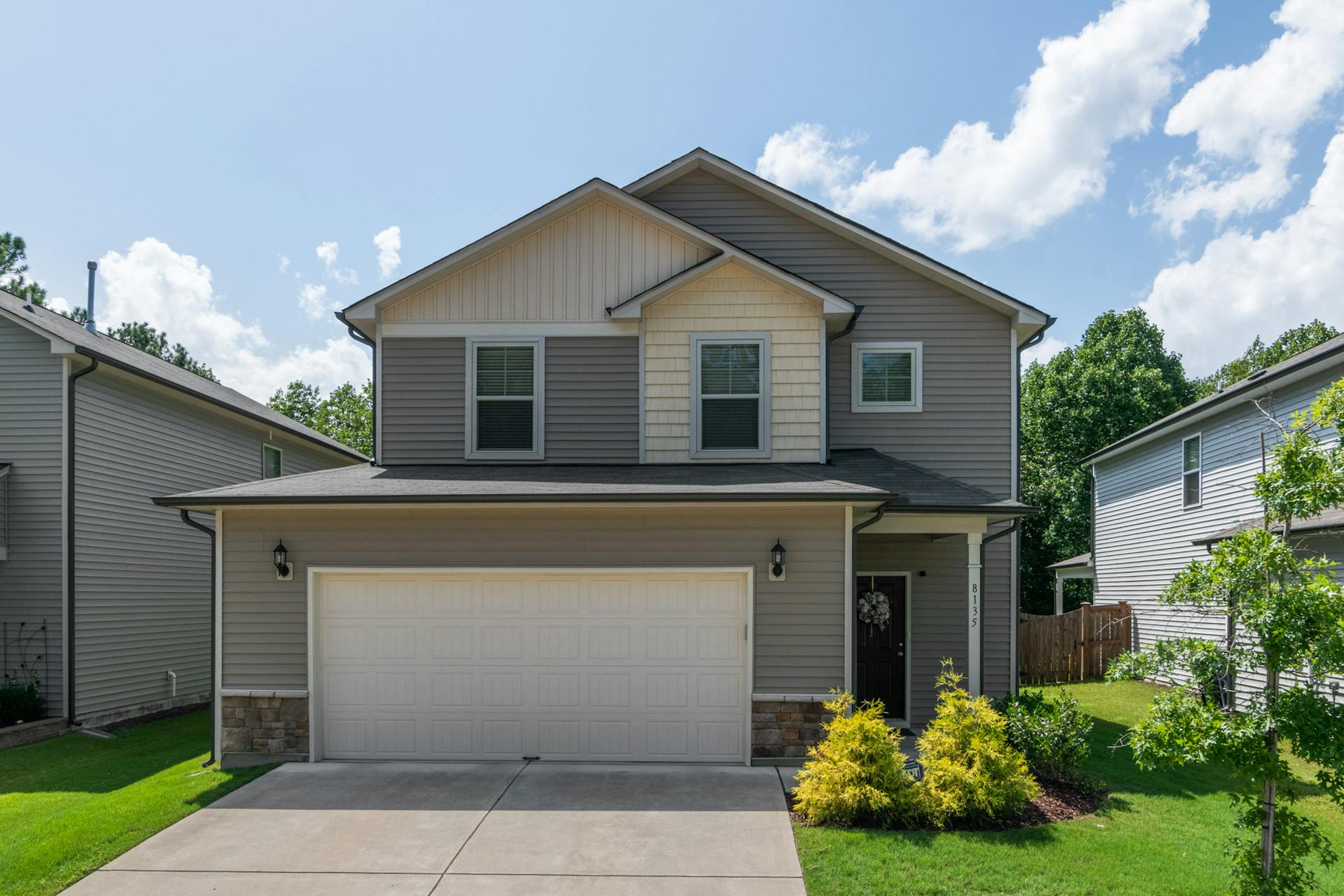
Heloc rates can be influenced by the lender's risk assessment of the borrower, which considers factors such as credit score, income, and debt-to-income ratio.
A lender's risk assessment is based on a borrower's credit score, which is a three-digit number that represents their creditworthiness.
The lender also considers the borrower's income and debt-to-income ratio, which is the percentage of their monthly gross income that goes towards paying debts.
Interest rates for Heloc loans can be fixed or variable, depending on the lender's terms.
If this caught your attention, see: Heloc with 650 Credit Score
How HELOC Rates are Determined
HELOC rates are determined by a combination of factors, including the borrower's credit score, loan-to-value ratio, and market conditions. The lender's risk assessment plays a significant role in setting the interest rate.
A credit score of 760 or higher can qualify you for a lower HELOC rate, while a score below 620 may result in a higher rate. This is because lenders view borrowers with higher credit scores as less risky.
Market conditions, such as the prime lending rate, also influence HELOC rates. When the prime rate rises, HELOC rates tend to follow suit.
Intriguing read: Coupon Rate vs Market Rate
Loan-to-Value (LTV) Ratio

The Loan-to-Value (LTV) ratio is a crucial factor in determining HELOC rates. It's the percentage of the home's value that you're borrowing against.
For example, if your home is worth $200,000 and you're borrowing $100,000, your LTV ratio is 50%. This means you're not using all of your home's value to secure the loan.
A higher LTV ratio can increase your HELOC rate, as lenders take on more risk by lending a larger portion of the home's value. This is because they're more likely to end up with a property that's worth less than the loan balance if you default.
In general, lenders prefer an LTV ratio of 80% or less, as this provides a more stable margin of safety.
For your interest: Does Heloc Affect Debt to Income Ratio
Lines of Credit Terms and Definitions
A Line of Credit is a type of revolving credit that allows you to borrow and repay funds as needed, up to a maximum limit.
The interest rate on a Line of Credit is often tied to a variable rate, which can change over time.

The draw period is the time frame during which you can borrow funds from a Line of Credit, typically ranging from 5 to 10 years.
Repayment is usually made through regular payments, with the option to pay more or less than the minimum payment.
The credit limit is the maximum amount of money you can borrow from a Line of Credit, which can be determined by your creditworthiness and income.
The interest rate on a Line of Credit can be fixed or variable, with variable rates often tied to a benchmark rate such as the Prime Rate.
The repayment term is the time frame during which you must repay the borrowed amount, which can be up to 20 years or more.
A Line of Credit can be secured or unsecured, with secured lines requiring collateral and unsecured lines not requiring collateral.
You might like: Figure Heloc Funding Time
Types of HELOCs and Rates
There are several types of HELOCs, including fixed-rate, variable-rate, and interest-only HELOCs.

A fixed-rate HELOC has a fixed interest rate for a certain period, typically 5-10 years, and then reverts to a variable rate.
Variable-rate HELOCs have an interest rate that can change over time, often tied to a benchmark like the prime rate.
Interest-only HELOCs allow borrowers to pay only the interest on the borrowed amount for a set period, often 5-10 years, before switching to principal and interest payments.
HELOC rates are influenced by the prime rate, which is the interest rate that banks charge their most creditworthy customers.
The prime rate can have a significant impact on HELOC rates, with a 0.5% change in the prime rate resulting in a $50 increase on a $100,000 HELOC.
Some lenders offer introductory rates, which can be lower than the regular rate, but may increase after a promotional period.
Related reading: Are Heloc Rates Fixed or Variable
Applying for a HELOC
Applying for a HELOC involves a similar process to applying for a mortgage, with lenders considering your credit score, income, and debt-to-income ratio. A good credit score can help you qualify for a HELOC.
Lenders will typically require you to provide financial documents, such as pay stubs and bank statements, to verify your income and creditworthiness. This is because a HELOC is a line of credit that allows you to borrow funds up to a certain limit.
A different take: What Credit Score Do You Need for Heloc
Heloc Applications

A HELOC application typically requires a good credit score, with a minimum score of 620 being common among lenders.
Having a stable income and a low debt-to-income ratio can also make your application more attractive.
You'll need to provide financial documents, such as pay stubs and tax returns, to support your income and creditworthiness.
Lenders will also consider the value of your home, which typically needs to be at least 20% above the loan amount to qualify.
Worth a look: Stated Income Heloc Lenders
Loan Requirements
To qualify for a HELOC, you'll need to meet some basic requirements. Your credit score must be at least 620 to be considered.
Typically, lenders require a debt-to-income ratio of 36% or less. This means your monthly debt payments shouldn't exceed 36% of your gross income.
Your home's value will also be a factor, as it serves as collateral for the loan. You'll need to have at least 20% equity in your home to qualify.
Lenders will also consider your income stability and employment history, so be prepared to provide documentation.
Discover more: When Will Chase Offer Heloc Again
Understanding HELOC Fees and Terms

HELOCs often come with origination fees, which can range from 0.5% to 5% of the loan amount, as seen in the example of a $200,000 HELOC with a $2,000 origination fee.
These fees can be paid upfront or rolled into the loan balance, adding to the overall cost of the HELOC.
The interest rate on a HELOC can be variable or fixed, with variable rates often tied to a prime rate or an index like LIBOR, as in the case of a HELOC with a prime rate plus 2% interest rate.
HELOCs may also come with annual fees, which can range from $50 to $1,000 per year, depending on the lender and the terms of the loan.
The draw period is the time during which you can borrow funds from your HELOC, typically ranging from 5 to 20 years, as in the case of a HELOC with a 10-year draw period.
Repayment periods can vary, but are often 10 to 20 years, during which you'll need to repay the loan balance, plus interest, as in the case of a HELOC with a 15-year repayment period.
Intriguing read: 5 Day Heloc
Sources
- https://www.investopedia.com/terms/h/homeequityloan.asp
- https://www.discover.com/home-loans/articles/how-home-equity-loans-work-rates-terms-repayment/
- https://www.sccu.com/articles/home-mortgage/how-does-a-home-equity-line-of-credit-work-a-guide
- https://www.patelco.org/credit-cards-and-loans/home-equity/line-of-credit
- https://www.quorumfcu.org/learn/home-and-family/helocs-know-the-lingo/
Featured Images: pexels.com


